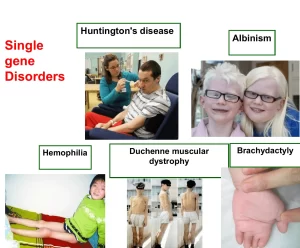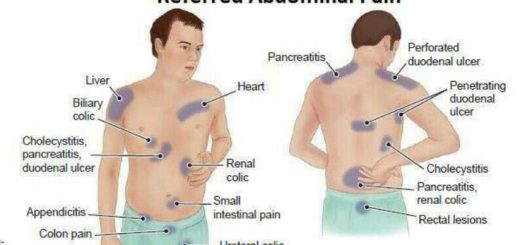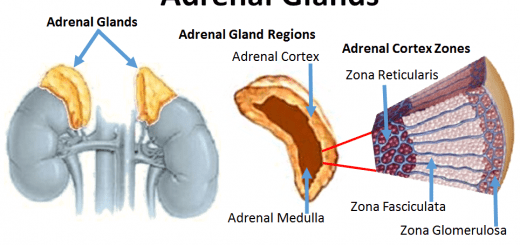Mendelian and non Mendelian inheritance, Single Gene Disorders and Sex Linked inheritance
Single gene disorders result from single mutant genes with a potentially large effect on a patient’s health. They may follow a simple Mendelian mode of inheritance or follow a non-classical (non-Mendelian) mode of inheritance. There are currently over 11,000 disorders known to result from single genes (Online Mendelian Inheritance in Man “OMIM”). Most of these disorders are rare but overall they represent 1-2% of the general population.
Single Gene Disorders
- Allele: alternative forms of a gene at a given locus, For example, the ABO blood group is composed of A, B, and O alleles encoding the three different RBC surface antigens.
- Locus: position occupied by a gene on a chromosome.
- Genotype: the genetic constitution of an individual, i.e. the particular genes at a given locus.
- Phenotype: the observed expression of a particular gene or genes.
- Polymorphism: two or more alternative genotypes, present at a frequency of > 1% in a certain population or not associated with a diseased phenotype, regardless of the frequency. This gene level variation is not likely to affect markedly the encoded protein function.
- Mutation: permanent heritable change in the DNA sequence.
- Dominant Trait: those conditions, which are phenotypically expressed in heterozygotes (i.e. individuals with one normal and one mutant allele of a gene).
- Recessive Trait: Those conditions which are expressed only in homozygotes (i.e. individuals who posses both mutant alleles of a particular gene locus).
- Co-dominance: the term used if both alleles are expressed in a heterozygote, e.g. AB blood group.
- Carrier: An individual heterozygous for a mutant allele that generally causes disease only in the homozygous state (recessive) and is phenotypically normal.
Mendelian inheritance
Mendelian inheritance is that determined by a particular genotype at one locus ie. Single Gene Trait. Mendelian characters may be determined by loci on an autosome or on the X and Y sex chromosomes. Dominance and recessiveness refer to characters and not genes. Males are hemizygous for loci on the X and Y chromosomes therefore the question of dominance and recessiveness does not arise in males for X- or Y-linked characters. Principles of Mendelian inheritance of traits from parents to offspring are determined by independent assortment and segregation of chromosomes and genetic loci resulting from crossing over during meiosis.
Characteristics of different modes of Mendelian Inheritance
Autosomal dominant inheritance (AD)
An AD trait is largely or completely expressed in a heterozygote.
Characteristics of AD Inheritance
- An affected person usually has at least one affected parent (unless due to a new mutation). The pedigree usually shows a vertical” transmission of traits among generations.
- Affects either sex.
- Transmitted by either sex.
- It commonly presents in heterozygous, homozygote form of the disease is usually very rare and when it occurs it usually shows a more severe phenotype than the heterozygote for example with a severe and lethal form of the disease. e.g. achondroplasia or present at an earlier age e.g familial hypercholesterolemia. However, in some diseases such as Huntington’s disease, the homozygote is not more severely affected than the heterozygote.
- Involved genes usually encode regulatory proteins of complex metabolic pathways (for example growth promoting protoncogenes) or key structural proteins, for example, fibrillin in Marfan Syndrome).
- Genetic risk A child of an affected parent has a 50% (1 in 2) chance of being affected independent of sex, assuming that the affected parent is heterozygous.
Examples of AD disorders
- Nervous System: Huntington’s disease, Neurofibromatosis, Myotonic Dystrophy.
- Urinary: adult polycystic kidney disease resulting in renal failure at around 40 years of age.
- GIT: Familial adenomatous polyposis which predisposes to colon cancer.
- Hematopoietic: Hereditary spherocytosis causes one type of hereditary haemolytic anemia.
- Skeletal Marfan Syndrome, Achondroplasia.
- Metabolic: Familial hypercholesterolaemia.
Autosomal recessive inheritance
These traits are expressed only in homozygotes or when both alleles of the genes are defective by different mutations (compound heterozygous).
Characteristics of AR inheritance
- Affected people are usually born to unaffected parents.
- Parents are usually asymptomatic (healthy) carriers.
- There is an increased incidence of consanguinity among parents.
- Affects either sex and is transmitted by either sex.
- The pedigree usually shows “horizontal transmission of the trait in one generation of carrier parents.
- Usually, enzyme proteins are involved
- Genetic risk: After the birth of an affected child there is a 1:4 risk of recurrence in successive children and there is a 1:2 chance of being a healthy heterozygote carrier, assuming that both parents are heterozygous carriers.
Examples of AR inherited disorders
- Metabolic: cystic fibrosis, most cases of inborn errors of metabolism, for example, phenylketonuria, and also lysosomal storage disease.
- Hematopoietic sickle cell anaemia, thalassemia resulting in haemolytic anemias.
Sex Linked inheritance
It is the pattern of inheritance shown by genes that are located on either sex chromosome, X-Linked and Y-linked, Since males are hemizygous for both sex chromosomes, therefore any sex-linked mutation on X or Y chromosome will be expressed in them.
X-Chromosome Inactivation: Basis and Nature of the Barr Body
In females during early embryonic life, one X chromosome is inactivated due to “dosage compensation” in females, since males have only one X chromosome, this ensures that females’ cells will produce gene products in quantities roughly similar to that produced from the single X chromosome in males.
However, both X-chromosomes must be active during the early weeks of embryonic life for normal gonadal development in a female. This X chromosome inactivation is characterized by being random, stable, passed on to all daughter cells, and is incomplete as some loci remain active on both X chromosomes, This phenomenon was first proposed by Mary Lyon hence called the Lyon Hypothesis.
Hence actually females are mosaic in respect to the active X chromosome in their body cells. This is exemplified in the Calico Cat where only females show patches with black and orange since the gene for black colour is on the X-Chromosome. Male cats of this breed do not exhibit alternating colours.
In abnormal cells with more than two X chromosomes only one X chromosome remains active and all the other Xs are inactivated and form Barr Bodies. Therefore, the number of Barr bodies observed is always n-1, where n is the number of X chromosomes.
X-linked recessive inheritance
- Affects mainly, males.
- Affected males are usually born to asymptomatic carrier mothers and may have affected male relatives from the maternal side.
- Females may be affected if the father is affected and the mother is an asymptomatic carrier, or occasionally as a result of the random X-inactivation in which most of the abnormal X chromosome is the active one in most of her cells.
- Genetic risk an affected male never transmits the disease to his sons but all his daughters will be obligate carriers of the trait, who may transmit the disease to their sons in the future, thus showing a “diagonal pattern of transmission (Due to affected male relatives on the maternal side).
Examples of X-linked recessive inheritance
- Musculoskeletal: Duchenne muscular atrophy.
- Blood: Hemophilia A and B, glucose 6-phosphate dehydrogenase deficiency causing favism.
- Immune Agammaglobulinemia causing primary immunodeficiency.
- Metabolic Diabetes insipidus.
- Nervous: Fragile X-Syndrome.
X-linked dominant inheritance
- Affects either sex, but within a family, there are more females affected than males.
- Females are often more mildly affected than males due to Lyonization.
- The child of an affected female, regardless of the sex has a 50% chance of being affected.
- In the case of an affected male, all daughters, but non of the sons will be affected.
An example is Vitamin D-resistant rickets. Differentiation between X-linked recessive and dominant inheritance is difficult because of X-inactivation, “Lyonization” (dosage effect to compensate for the single copy of X chromosome in males), which blurs the distinction of both types.
Y-linked inheritance
- Affects only males.
- All affected males have an affected father unless it resulted from a new mutation.
- Genetic risk: Transmitted to all sons of an affected male.
Examples: hairy ears, azoospermia (one of the causes of infertility due to SRY gene mutation, males may have offspring by assisted reproduction).
Some Unusual features in single gene patterns of inheritance
Pleiotropy
Two or more unrelated effects result from a single gene disorder, e.g. neurofibromatosis which involves skin hyperpigmented patches, CNS tumours and neurofibromas. Lisch nodules of the iris.
Variable expressivity
The disease shows variation in the clinical phenotype among generations within the same family. For example Adult polycystic kidney disease: some cases present with renal failure early in adulthood whilst others show few renal cysts that renal function. not significantly alter renal function.
Reduced/Incomplete Penetrance
This is a condition in which the individual might carry the gene of an AD disorder yet does not show clinical evidence of the disorder. E.g. familial cancer, such as retinoblastoma, which despite being AD genetically inherited cancer yet its penetrance is less than 100%.
Anticipation
It is the concept of a genetic disease showing more severe phenotypes in successive generations. This is because of the underlying type of mutation causing the disorder results in more-unstable DNA (Dynamic mutation resulting from the unstable expansion of triplet DNA repeats within the gene in coding or noncoding regulatory sequence). For example, some diseases such as Huntington disease (juvenile HD), Myotonic dystrophy (congenital MD), and Fragile X Syndrome (severe mental retardation) present with a severe phenotype with large repeats in younger generations.
New mutation
An affected person with an AD disorder without the affection of the parents or there is a negative family history of the disorder (e.g. Achondroplasia; a form of short-limb dwarfism) results from a new mutation (germline mutation of the gene in one of the gametes) usually is associated with advanced age of the father due to the large number of mitotic divisions which male gamete stem cells undergo during the reproductive lifetime.
Mosaicism
It is the presence of more than one cell line within an individual. This results from a mutation in one of the early divisions of the zygote. The phenotype depends on the proportion and distribution of the cells carrying the mutation and also whether it is in somatic or germ cells. If localized to the somatic cells of an individual, it will not be transmitted to his/her offspring, while if the mosaicism is gonadal, there may be more than one of the offspring affected while the parents are completely normal.
Locus/Genetic Heterogeneity (Genocopy)
A disorder inherited in the same manner can be due to mutations in more than one gene (at different loci) and yet shows the same phenotype, for example, certain types of hearing loss (congenital hearing loss) most commonly are AR and could result from 20 different genes. If both parents have hearing loss resulting from different genes, their offspring will be heterozygous at both loci and hence will not be affected.
You can subscribe to science online on Youtube from this link: Science Online
You can download Science Online application on Google Play from this link: Science Online Apps on Google Play
Polygenic inheritance vs Single gene inheritance, Non-mendelian inheritance and Genomic imprinting
Chromosomal disorders, structure, classification, and Types of numerical chromosomal abnormalities
Genes, Chromosomes, Proteins, Bacteriophages & Quantity of DNA in the cells
Nucleus components, function, diagram & classification of chromosomes
Cells types, Chromosomes, Cell division, Phases of mitosis division & Liver Transplantation
Packaging of DNA, Genome, chromosomal proteins, DNA in Prokaryotes & Eukaryotes




